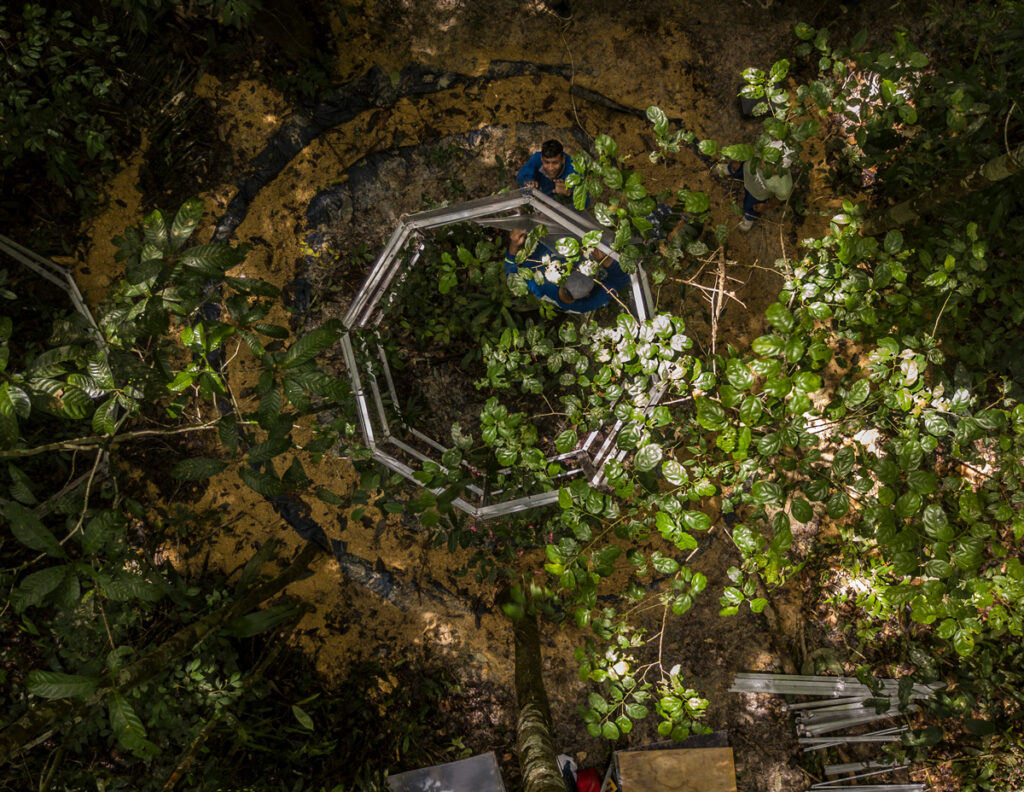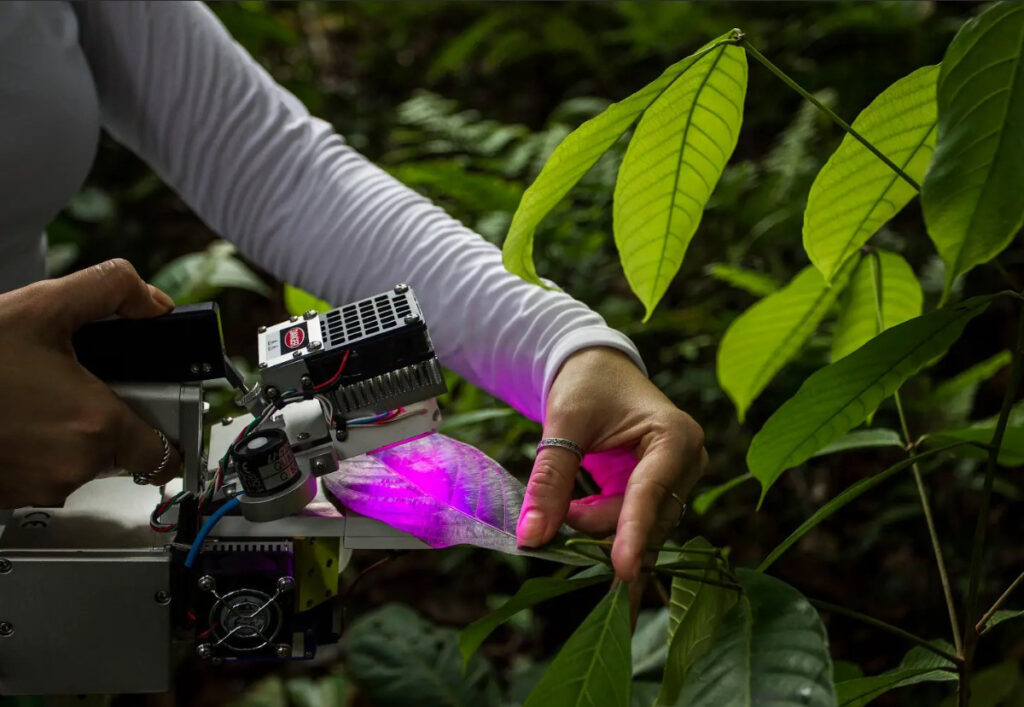The Amazon plays an essential role in climate, absorbing a quarter of all the carbon stored in the world’s forests. But no one knows how the world’s largest rainforest will respond to the increasing amounts of carbon emitted into the atmosphere by humans. Will it absorb more carbon and thrive, or will it reach a tipping point and become a savanna?
Even less is known about the effects of high emissions on the forest’s understory—the lower layer of vegetation formed by small trees and shrubs topping out between the forest canopy and the floor.
Though it absorbs just under half as much carbon as the canopy, this layer plays an important role in the forest. All trees pass through this layer while growing, and other plant species live there throughout their lives.
“These plants are important in ecological relationships,” said Sabrina Garcia, a biologist at the National Institute for Amazonian Research, a research center linked to the Brazilian Ministry of Science, Technology and Innovation. “They provide food for animals and also have their share in the carbon sink.” Garcia is the colead author of a new paper in Plant, Cell and Environment studying how the forest understory responds to elevated carbon dioxide (CO2) levels.
The new study is part of the larger project AmazonFace. This multimillion dollar open-air experiment in the Brazilian Amazon will release carbon into the tree canopy via 35-meter-high metal towers to study how the rainforest responds. The first tests are set to run later this year. In the meantime, the researchers from the international consortium running the experiment began setting up smaller open-top chambers in the forest in 2019.

Like greenhouses without ceilings, these 3-meter-high chambers have transparent walls that encircle forest patches and inject CO2 into plants’ surroundings through a gas line. Researchers used these tools to test the response of the forest’s lower layers to carbon-saturated air.
“To see a study like this from a really important ecosystem in the central Amazon is very exciting,” said David Ellsworth, an ecologist at Western Sydney University, Australia, who was not involved in the research.
Ellsworth, who spent 30 years studying the Amazon and is a leader in experiments exposing vegetation to elevated CO2 levels, is impressed with the logistics of setting up the chambers in the forest. So far, most experiments using this technique were done on clearings and crops. “To do research like this in the forest is amazing, because it is logically so difficult to do this kind of study.”
Life in the Shadows
Plants in the understory live practically in the shadows. Typically, only about 5% of sunlight filters down from the canopy.
Researchers hypothesized that plants in the understory would be particularly good at soaking carbon from the air because they live in a constant state of “hunger” for light. Their idea was that these plants would use the extra gas, for example, to grow larger leaves with more surface area for capturing light.
“They are taking the extra CO2 and depositing it in some structures, for example, increasing their leaf surface.”
However, studies to test this hypothesis have been scarce and have mostly been done with seedlings growing in pots. In the new study, the researchers set up eight open-top chambers in the forest, half under normal conditions and the other half injected with air containing 250 parts per million of CO2. This amount corresponds to the extra gas that predictions suggest will be in the atmosphere 50 years from now if emissions follow current trends.
For a year, they measured the plants’ leaf areas, stem diameters, heights, and growth rates. They found that the plants in the understory absorbed the carbon and used it to grow: In 4 months, the understory plants exposed to the extra gas absorbed 67% more carbon and produced 85% more leaves than the other plants.
The researchers think the gas is helping the plants better exploit the erratic Sun flecks they get for photosynthesis. “They are taking the extra CO2 and depositing it in some structures, for example, increasing their leaf surface,” said colead author Amanda Damasceno, a master’s student at the National Institute for Amazonian Research at the time of the experiment.
Uncertain Future
The results might sound like good news at first glance. But the authors highlighted that these effects might change in the long run. As temperatures rise with the expected advance of climate change, the plants might not absorb carbon and grow in the same way.
“Will this increase in carbon absorption be, in fact, beneficial for the plants?” Damasceno asked. “To what extent will the plants respond?”

Transpiration is another factor in the equation. Just like us, plants sweat. They release water through their stomata, small pore-like holes in their leaves, to keep their temperature stable. They use these same structures to absorb carbon from the air. Scientists have conjectured that plants could change their transpiration rates in carbon-saturated environments.
When there is a lot of CO2 in the air, the plants don’t need to open their stomata much to absorb the gas. In return, they reduce their transpiration and the amount of water they release into the air.
In the new study, the understory plants maintained their normal transpiration rates. However, Garcia worries that this could change in the long term, possibly altering the region’s rain regime. “For now, the understory plants have been shown to be efficient in water use, being able to absorb carbon without losing water,” said Garcia. “But this could be a one-off effect.”
Sweating Rain
Amazonian plants are rainmakers. Their transpiration forms so-called flying rivers, kilometers-long streams of moisture that circulate via air currents passing over fields, forests, and cities in South America. The humidity these rivers carry is responsible for much of the rain that falls on the continent.

Several studies over the years have suggested that in a carbon-saturated environment with extreme climate change, the Amazon could become a dry savanna, reducing rainfall in South America. Under this scenario, the landscape would become a carbon source rather than a carbon sink.
The researchers will continue tracking the longer-term effects in the experimental area, and they will rely on the results of the larger AmazonFace experiment to gain a more complete picture of the forest’s future.
“We know so little about the climate and the CO2 responses of tropical vegetation in general and the Amazonian specifically that anything that we do scientifically is a leap forward,” said Ellsworth. “This study is a great stepping stone.”
—Sofia Moutinho (@sofiamoutinhoBR), Science Writer
29 April 2024: The article was updated to provide the correct year in which researchers began to set up open-top chambers in the Amazon.

